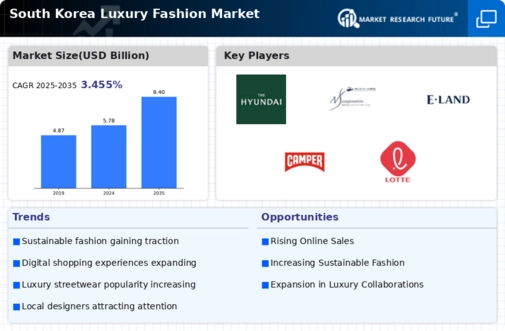Rising Affluence and Consumer Spending
The luxury fashion market in South Korea is experiencing a notable surge in consumer spending, driven by rising affluence among the population. As disposable incomes increase, consumers are more inclined to invest in high-end fashion items. Recent data indicates that the average household income in South Korea has risen by approximately 5% annually, leading to a greater willingness to purchase luxury goods. This trend is particularly evident among millennials and Gen Z consumers, who prioritize brand prestige and quality. The luxury fashion market is thus benefiting from this demographic shift, as younger consumers seek to express their individuality through premium products. Furthermore, the increasing number of high-net-worth individuals in South Korea is likely to further bolster demand for luxury fashion, creating a robust market environment for luxury brands to thrive.
Sustainability and Ethical Consumption
The luxury fashion market in South Korea is increasingly influenced by sustainability and ethical consumption trends. As consumers become more environmentally conscious, there is a growing demand for luxury brands that prioritize sustainable practices. Recent surveys indicate that approximately 60% of South Korean consumers are willing to pay a premium for products that are ethically sourced and produced. The luxury fashion market is responding by adopting eco-friendly materials and transparent supply chains, which not only appeal to conscious consumers but also enhance brand reputation. This shift towards sustainability is likely to reshape the competitive landscape, as brands that fail to adapt may struggle to attract discerning customers. Moreover, the emphasis on ethical consumption is fostering innovation within the industry, encouraging brands to explore new sustainable practices and technologies.
E-commerce Growth and Digital Engagement
The luxury fashion market in South Korea is witnessing a rapid transformation due to the growth of e-commerce and digital engagement. With an increasing number of consumers preferring online shopping, luxury brands are adapting their strategies to enhance their digital presence. Recent statistics reveal that online sales in the luxury fashion market have surged by over 25% in the past year, indicating a shift in consumer behavior. The luxury fashion market is capitalizing on this trend by investing in user-friendly websites and mobile applications, providing seamless shopping experiences. Additionally, social media platforms are playing a pivotal role in driving online sales, as brands utilize targeted advertising and influencer partnerships to reach potential customers. This digital shift not only broadens market access but also allows brands to engage with consumers in innovative ways, fostering brand loyalty and repeat purchases.
Cultural Heritage and Local Craftsmanship
The luxury fashion market in South Korea is increasingly embracing cultural heritage and local craftsmanship as key drivers of consumer interest. As consumers become more aware of the value of artisanal products, there is a growing demand for luxury items that reflect traditional craftsmanship. This trend is evident in the rise of brands that incorporate local materials and techniques into their designs, appealing to consumers' desire for authenticity. The luxury fashion market is thus witnessing a resurgence of interest in products that tell a story and celebrate cultural identity. Furthermore, collaborations between luxury brands and local artisans are becoming more common, enhancing the perceived value of products. This focus on cultural heritage not only differentiates brands in a competitive market but also resonates with consumers seeking meaningful connections with their purchases.
Influence of K-Pop and Celebrity Endorsements
The luxury fashion market in South Korea is significantly influenced by the global phenomenon of K-Pop and celebrity endorsements. South Korean celebrities, particularly K-Pop idols, have become powerful trendsetters, often collaborating with luxury brands to create exclusive collections. This phenomenon has led to a substantial increase in brand visibility and desirability among consumers. For instance, luxury brands that partner with popular K-Pop groups have reported sales increases of up to 30% following collaborations. The luxury fashion market is thus leveraging these endorsements to attract younger consumers who aspire to emulate their favorite stars. The cultural impact of K-Pop extends beyond music, as it shapes fashion preferences and purchasing behaviors, making celebrity influence a critical driver in the luxury fashion market.
















Leave a Comment